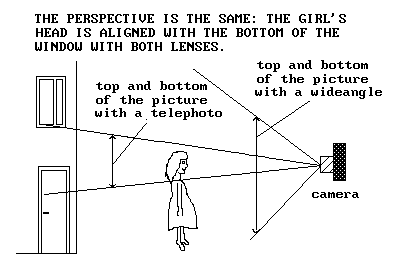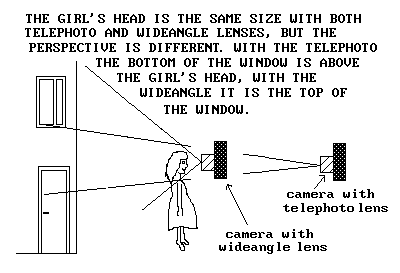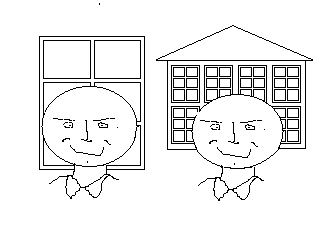One of the main reasons for buying an SLR, apart from being able to see what you will get, is to be able to change the lens in order to change the image size. This has become much easier with the development of high quality zoom lenses which enable you to frame your subject precisely when you take the picture. If you are making prints, this means that you don't have the problems of over-enlargement and heavy grain in your prints. As a spin-off bonus from this control of image size you are also able to control perspective. That is, the relative visual importance of your subject and the background, in ways other than by the use of differential focus.
Many people think that wide angle lenses expand perspective and long focus lenses compress it. That is, they say that wide angle lenses will increase the distance from a subject in the foreground to another in the background, while a telephoto will bring them closer together. It's not true!
All that lenses of different focal lengths do is to alter the size of the image on the film WITHOUT altering the perspective. To prove this to yourself take a series of lenses that will enable you to cover several focal lengths from wide angle, e.g. 28mm on 35mm film to longish telephoto, say something in the range 200mm to 300mm. Now go and find yourself a test scene with a reasonable foreground and background. Auntie Flo standing, let's say 30 feet from the camera, with her house behind her at three hundred feet from the camera will do nicely. Set your camera up on a tripod and take a series of shots at the smallest aperture ( biggest number f-stop ) using the range of focal lengths FROM THE SAME SPOT. Then repeat the exercise, this time, however, move closer or further away from Auntie Flo so that as you change focal lengths from wide angle to long focus you KEEP THE IMAGE OF THE PERSON THE SAME SIZE in the viewfinder. The focusing aid in the middle of the viewfinder will be very useful in enabling you to judge that you have kept the image of the foreground subject constant.

Now go and develop the film, or take it your favourite D & P house. When the prints are ready look carefully at them and you will find that you have learnt quite a lot about image control.
First of all look at the series that you took all from the same viewpoint. The first thing that you will notice is that the main subject, Auntie Flo, appears insignificant in the frame in the wide-angle shots but large and important in the long focus shoots. There is also much less distracting surrounding detail in the long focus shots, but if you look carefully at the RELATIVE SIZE of Auntie Flo and the house behind her, you will see that they do not change, Auntie Flo appears to be the same size in relation to the house no matter what focal length of lens was in use! In other words the perspective has NOT CHANGED with focal length. If you make your own enlargements, you can prove this to yourself in an even better way by making selective enlargements from the negatives taken with the shorter focal lengths to match the image from the longest focal length. Apart from the size of the grain there should be little or no difference in the image. In other words perspective is controlled by DISTANCE FROM THE SUBJECT, not the focal length of the lens in use!

This point is driven home when you look at the second series of prints, where you moved around to keep the image of Auntie Flo the same size in the picture as you changed focal length. Here you will see that, in those pictures where you were using a short focal length ( wide angle lens ), then Auntie Flo is large relative to the house behind, emphasising her importance in the picture but at the same time, because the house is recognisable as such, putting her into the context of where she lives. When you look at the pictures taken with the long focus (tele) lens, you find that Auntie Flo is totally overshadowed by her house, which appears to be breathing down her neck! The classic compression of the image that we associate with long focus lenses. So now you can see that you can control the relationship of the main subject to the background by CHOOSING YOUR VIEWPOINT, close to the subject to increase its importance relative to the background, and far away to pull foreground and background together. You control the image size of the main foreground subject by the choice of focal length.

If you did not stop down to a very small stop when you took your series of pictures from a fixed point you will have realised that, along with the change of image size, there is also a corresponding change in apparent depth of field with change in focal length. A short focal length lens appears to have a greater depth of field at any given f-stop than a long focus lens. This difference in depth of field will again appear to be much less in the series where image size was kept constant, because Auntie Flo will be much nearer to the camera relative to the house when you took the wide angle shot than when you took the long-focus shot. The depth of field needed to get both in focus on the wide-angle shot is much more than with the long focus shot, and so the apparent difference in depth of field between the lenses disappears! You can use this relationship to help you control differential focus, in addition to using the f-stop in the normal way.
Maybe different focal length lenses did not work in the way that you expected, but having understood how focal length and viewpoint interact to affect perspective and apparent depth of field, I'm sure you will now be able to make much more effective use of your expensive extra wide angle, telephoto and zoom lenses! Good photography!
top of page